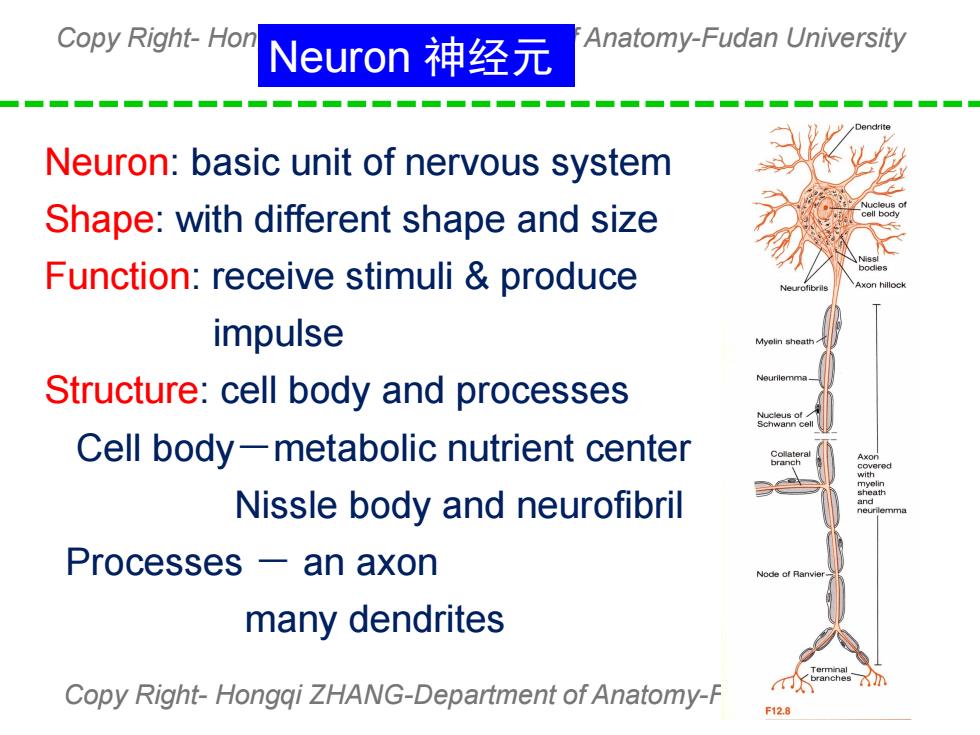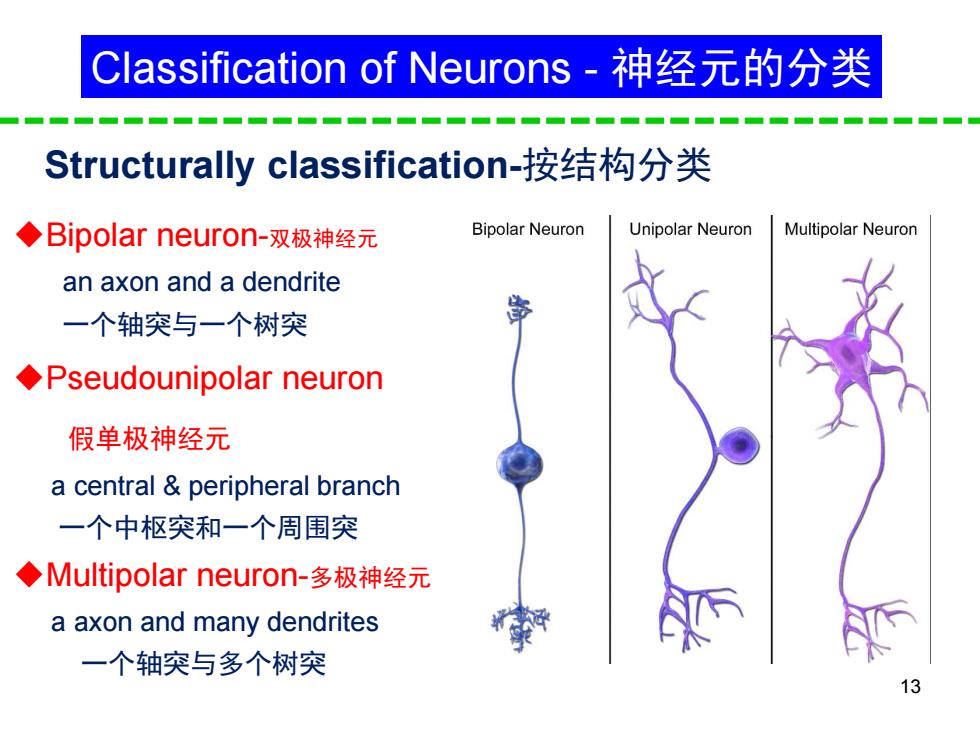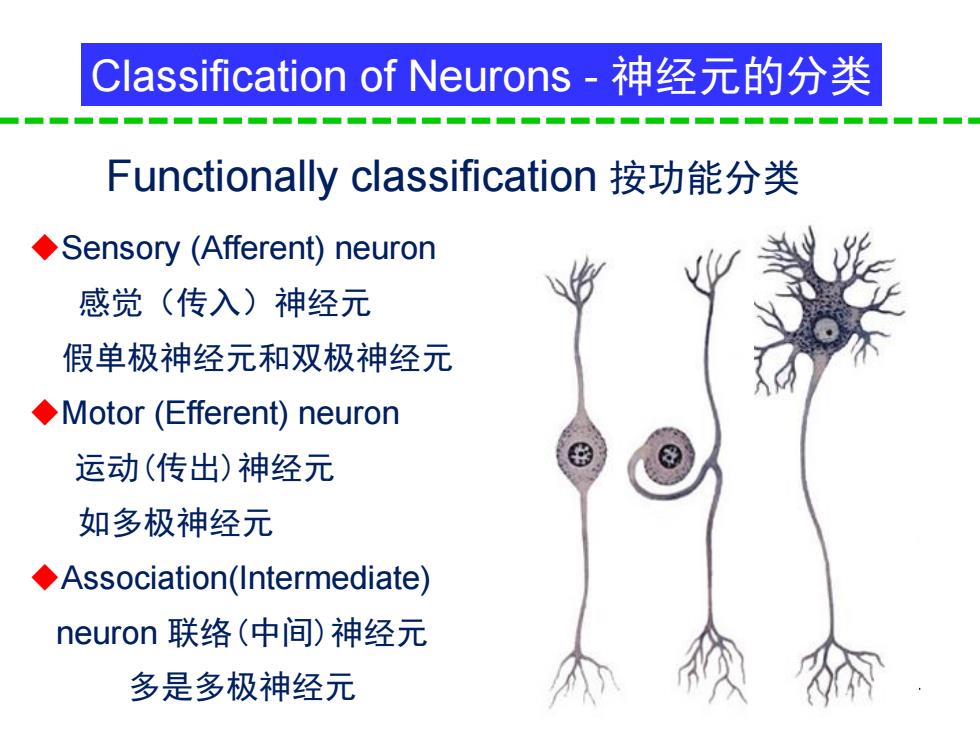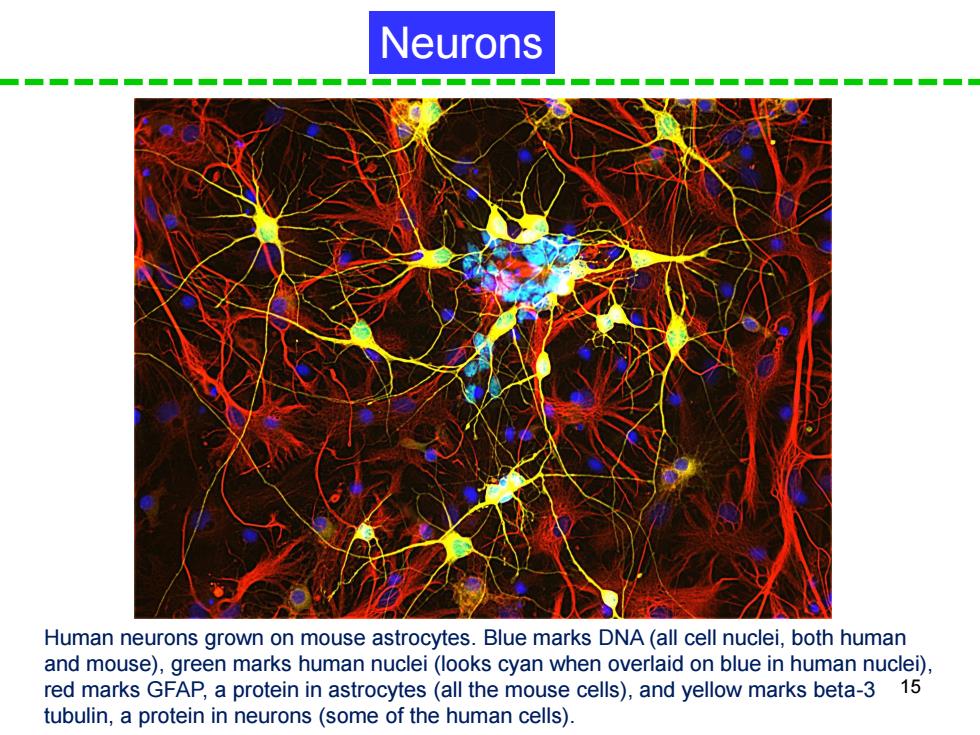
Copy Right-Hon Neuron神经元 Anatomy-Fudan University Neuron:basic unit of nervous system Shape:with different shape and size Function:receive stimuli produce impulse Structure:cell body and processes Cell body-metabolic nutrient center Nissle body and neurofibril Processes an axon many dendrites Copy Right-Hongqi ZHANG-Department of Anatomy-F 水na F12.8
Copy Right- Hongqi ZHANG-Department of Anatomy-Fudan University Copy Right- Hongqi ZHANG-Department of Anatomy-Fudan University Neuron 神经元 Neuron: basic unit of nervous system Shape: with different shape and size Function: receive stimuli & produce impulse Structure: cell body and processes Cell body-metabolic nutrient center Nissle body and neurofibril Processes - an axon many dendrites

Classification of Neurons-神经元的分类 Structurally classification-按结构分类 ◆Bipolar neuron-双极神经元 Bipolar Neuron Unipolar Neuron Multipolar Neuron an axon and a dendrite 一个轴突与一个树突 Pseudounipolar neuron 假单极神经元 a central peripheral branch 一个中枢突和一个周围突 ◆Multipolar neuron-多极神经元 a axon and many dendrites 一个轴突与多个树突
13 Classification of Neurons - 神经元的分类 Structurally classification-按结构分类 ◆Bipolar neuron-双极神经元 an axon and a dendrite 一个轴突与一个树突 ◆Pseudounipolar neuron 假单极神经元 a central & peripheral branch 一个中枢突和一个周围突 ◆Multipolar neuron-多极神经元 a axon and many dendrites 一个轴突与多个树突

Classification of Neurons-神经元的分类 Functionally classification按功能分类 Sensory (Afferent)neuron 感觉(传入)神经元 假单极神经元和双极神经元 Motor(Efferent)neuron 运动(传出)神经元 如多极神经元 Association(Intermediate) neuron联络(中间)神经元 多是多极神经元
14 Functionally classification 按功能分类 ◆Sensory (Afferent) neuron 感觉(传入)神经元 假单极神经元和双极神经元 ◆Motor (Efferent) neuron 运动(传出)神经元 如多极神经元 ◆Association(Intermediate) neuron 联络(中间)神经元 多是多极神经元 Classification of Neurons - 神经元的分类

Neurons Human neurons grown on mouse astrocytes.Blue marks DNA(all cell nuclei,both human and mouse),green marks human nuclei(looks cyan when overlaid on blue in human nuclei) red marks GFAP,a protein in astrocytes(all the mouse cells),and yellow marks beta-3 15 tubulin,a protein in neurons(some of the human cells)
15 Neurons Human neurons grown on mouse astrocytes. Blue marks DNA (all cell nuclei, both human and mouse), green marks human nuclei (looks cyan when overlaid on blue in human nuclei), red marks GFAP, a protein in astrocytes (all the mouse cells), and yellow marks beta-3 tubulin, a protein in neurons (some of the human cells)

卡哈尔与高尔基共同获得1906年Nobel生理医学奖 现代神经科学起源于十九世纪末期;圣地亚哥·拉蒙-卡哈尔(Santiago Ramon y)的神经解剖学研 究和他提出的神经元理论是主要的起点。一百多年来,神经科学界一直公认卡哈尔是有史以来最伟 大的神经解剖学家。 1.他通过细致的观察,提出了神经元的概念 2他指出所有神经元都具有不对称的极性结构:一边有一枝很长的所谓“轴突”的纤维状突起 ;另一边有许多像树枝一样的“树突”。他提出树突是接收其他神经元输入信息的结构,而轴突则是 神经元将信息传向远方的输出结构,神经信息在神经元内是单向地从树突流向轴突。 3.在发育组织的切片中,他发现了生长期的轴突前端有一种“生长椎”(growth cone)。卡哈尔对“ 生长椎”动态性的描述生动地反映了他的想象力:“一个柔软可变的破城槌,以机械力推开障碍,寻 找自己的途径,最终到达它的目的地”。 16
16 现代神经科学起源于十九世纪末期;圣地亚哥·拉蒙-卡哈尔(Santiago Ramón y)的神经解剖学研 究和他提出的神经元理论是主要的起点。一百多年来,神经科学界一直公认卡哈尔是有史以来最伟 大的神经解剖学家。 1.他通过细致的观察,提出了神经元的概念 2.他指出所有神经元都具有不对称的极性结构:一边有一枝很长的所谓 “轴突” 的纤维状突起 ;另一边有许多像树枝一样的 “树突”。他提出树突是接收其他神经元输入信息的结构,而轴突则是 神经元将信息传向远方的输出结构,神经信息在神经元内是单向地从树突流向轴突。 3.在发育组织的切片中,他发现了生长期的轴突前端有一种 “生长椎”(growth cone)。卡哈尔对 “ 生长椎” 动态性的描述生动地反映了他的想象力:“一个柔软可变的破城槌,以机械力推开障碍,寻 找自己的途径,最终到达它的目的地”。 卡哈尔与高尔基共同获得1906年Nobel生理医学奖